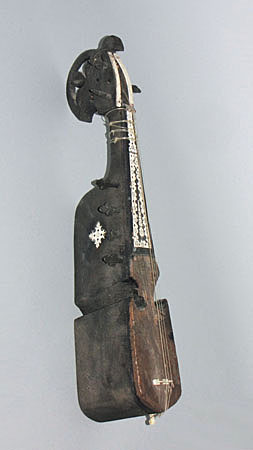
Owner: HWMC
Catalog#: 2AS-CHLT-54
Lutes
Afghanistan ‘Rubâb’ (B)
Afghanistan
Afghans
Mulberry wood, goat skin, nylon strings, ebony, abalone/shell, bone inlay
Mid 20th century
Length: 28.5 in
Chordophones – Lutes
Rabab is a term used for lute-type chordophones with a membrane sound table that may be plucked, strummed, and/or bowed. They are found in Central Asia, Southeast Asia, India, the Middle East and North Africa. While this Afghanistan rubâb (rabab) gets its name from the Arabic rebab that means ‘played with a bow,’ it is an instrument that is plucked, double chested, and quite different in construction from the rebab. The rubâb is known as ‘the lion of instruments’ and along with the zerbaghai (goblet drum, also found in this collection), is one of the two national instruments of Afghanistan.
This rubâb has a short neck with a single piece body carved from the trunk of a mulberry tree. It is used in traditional folk music both to accompany songs and as a melody instrument. The performer sits cross-legged and holds the instrument at a horizontal angle across their lap. The hollow double sound-chambers are connected by a narrow-indented tunnel. The three melody strings, tuned in fourths, are made of nylon. This rubab is smaller in size than example (A) in this collection, and has fewer sympathetic string (9), with 3 steel drone strings, tuned in 5ths.
Despite the censorship of music during the Taliban rule, the rubâb has regained its prominence in the Afghan culture.
Reference: “Rabab,” Carol M. Babiracki. “The Groves Dictionary of Musical Instruments,” 2nd ed., Lawrence Libin, Chief Editor in Chief. Oxford University Press
